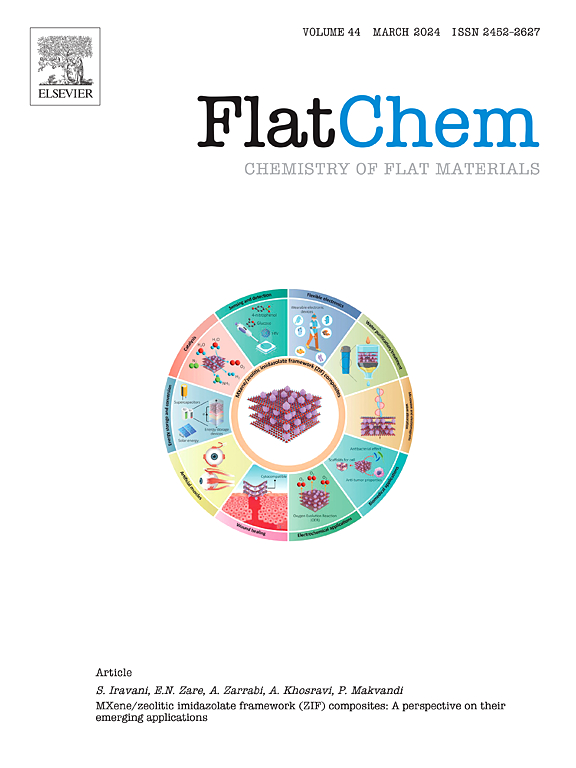缺陷工程tmd的合理设计:解锁MoS2, MoSe2和MoTe2中选择性捕获和催化的活性位点
IF 6.2
3区 材料科学
Q2 CHEMISTRY, PHYSICAL
引用次数: 0
摘要
钼基过渡金属二硫化物(TMDs)在CO2还原(CRR)、N2还原(NRR)和析氢(HER)等关键电化学和光化学反应中具有广阔的应用前景。然而,它们的催化性能受到其基面低反应性的固有限制,需要进行结构修饰以暴露化学活性过渡金属位点。在这里,我们对钼基tmd中的硫空位工程提供了基本的见解。利用大规模密度泛函理论(DFT)计算,包括NVT从头算分子动力学(AIMD)和密度泛函微扰理论(DFPT),我们研究了三种TMD单层- MoS2, MoSe2和MoTe2 -考虑原始和缺陷结构的三种硫空位大小,以及六种分子种类(N2, O2, NO, CO, CO2和NO2)的400例吸附情况。我们的研究结果表明,空位效应具有高度选择性,吸附增强作用因分子种类而异。虽然较大的空位通常会加强所有tmd之间的吸附,但它们也会放大内在的物理化学差异。MoTe2的结合能和分子变形最高,其次是MoSe2和MoS2。值得注意的是,空位工程的tmd对N2和CO2的吸附效果很好,其活化与结合比超过了许多传统催化剂。通过有策略地选择TMD成分和调整空位大小,可以精细地优化吸附强度和分子活化,从而产生明显的热力学优势。我们的研究结果表明,有缺陷的MoS2有利于CO2捕获和激活CRR,但抑制NRR并适度限制HER,而MoTe2抑制HER,同时促进NRR和CRR。这些见解确立了作为缺陷工程关键参数的硫选择,为合理设计先进的催化材料铺平了道路。本文章由计算机程序翻译,如有差异,请以英文原文为准。
Rational design of defect-engineered TMDs: Unlocking active sites for selective capture and catalysis in MoS2, MoSe2, and MoTe2
Molybdenum-based transition-metal dichalcogenides (TMDs) are promising catalysts for key electro- and photochemical reactions, including CO2 reduction (CRR), N2 reduction (NRR), and hydrogen evolution (HER). However, their catalytic performance is inherently limited by the low reactivity of their basal planes, necessitating structural modifications to expose chemically active transition-metal sites. Here, we provide fundamental insights into chalcogen-vacancy engineering in Mo-based TMDs. Using large-scale density functional theory (DFT) computations, including NVT ab initio molecular dynamics (AIMD) and density functional perturbation theory (DFPT), we examine 400 adsorption cases across three TMD monolayers — MoS2, MoSe2, and MoTe2 — considering both pristine and defective structures with three chalcogen-vacancy sizes, as well as six molecular species (N2, O2, NO, CO, CO2, and NO2). Our findings reveal that vacancy effects are highly selective, with adsorption enhancements varying significantly by molecular species. While larger vacancies generally strengthen adsorption across all TMDs, they also amplify intrinsic physicochemical differences. MoTe2 exhibits the highest binding energies and molecular deformation, followed by MoSe2 and MoS2. Notably, vacancy-engineered TMDs demonstrate promising adsorption for N2 and CO2, with activation-to-binding ratios surpassing many conventional catalysts. By strategically selecting TMD compositions and tailoring vacancy sizes, adsorption strength and molecular activation can be finely optimized, leading to distinct thermodynamic favorability. Our results show defective MoS2 favors CO2 capture and activation for CRR but suppresses NRR and modestly limits HER, whereas MoTe2 suppresses HER while promoting both NRR and CRR. These insights establish chalcogen selection as critical parameter in defect engineering, paving the way for rational design of advanced catalytic materials.
求助全文
通过发布文献求助,成功后即可免费获取论文全文。
去求助
来源期刊

FlatChem
Multiple-
CiteScore
8.40
自引率
6.50%
发文量
104
审稿时长
26 days
期刊介绍:
FlatChem - Chemistry of Flat Materials, a new voice in the community, publishes original and significant, cutting-edge research related to the chemistry of graphene and related 2D & layered materials. The overall aim of the journal is to combine the chemistry and applications of these materials, where the submission of communications, full papers, and concepts should contain chemistry in a materials context, which can be both experimental and/or theoretical. In addition to original research articles, FlatChem also offers reviews, minireviews, highlights and perspectives on the future of this research area with the scientific leaders in fields related to Flat Materials. Topics of interest include, but are not limited to, the following: -Design, synthesis, applications and investigation of graphene, graphene related materials and other 2D & layered materials (for example Silicene, Germanene, Phosphorene, MXenes, Boron nitride, Transition metal dichalcogenides) -Characterization of these materials using all forms of spectroscopy and microscopy techniques -Chemical modification or functionalization and dispersion of these materials, as well as interactions with other materials -Exploring the surface chemistry of these materials for applications in: Sensors or detectors in electrochemical/Lab on a Chip devices, Composite materials, Membranes, Environment technology, Catalysis for energy storage and conversion (for example fuel cells, supercapacitors, batteries, hydrogen storage), Biomedical technology (drug delivery, biosensing, bioimaging)
 求助内容:
求助内容: 应助结果提醒方式:
应助结果提醒方式:


